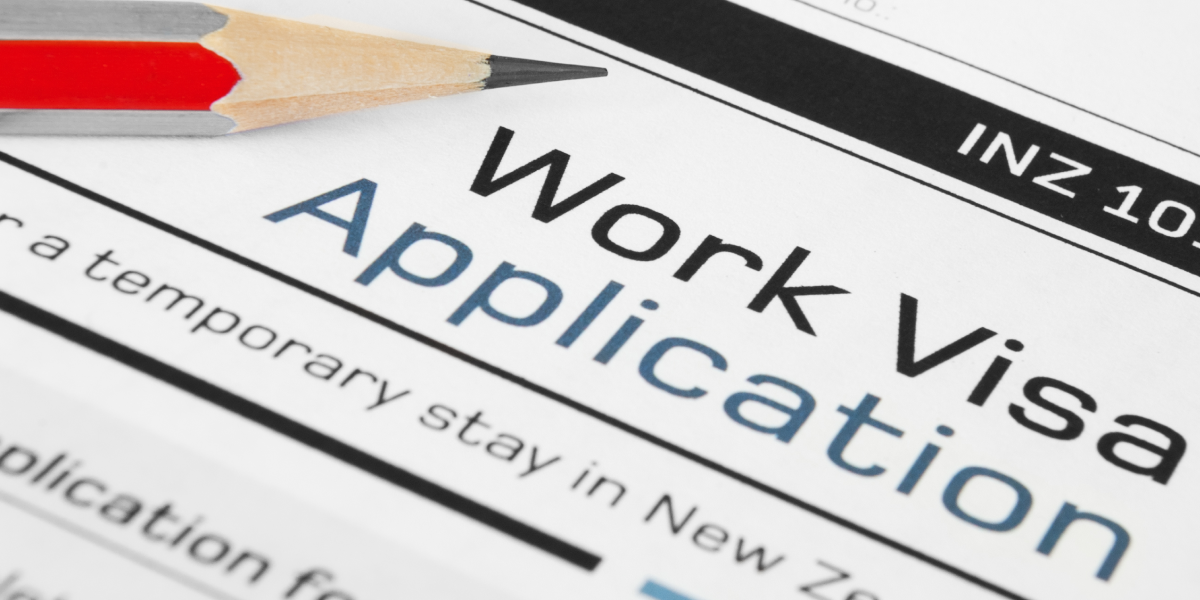Feature article
How the Accredited Employer Work Visa is affecting immigration
What you need to know about the Accredited Employer Work Visa
The AEWV, administered by Immigration NZ under the Ministry of Business, Innovation & Employment, wipes out 6 visas – Essential Skills Work Visa, the Talent (Accredited Employer) Work Visa, the Long Term Skill Shortage List Work Visa, the Silver Fern Job Search Visa, and the Silver Fern Practical Experience Visa.
Employers will need to go through three stages to complete the visa requirements: Accreditation, Job Check and Migrant Check.
Step 1: The Accreditation for the AEWV
In order to get accreditation:
- Employers will need to show their business is viable and profitable and has credible cash flow projections.
- That it meets immigration and employment standards and won’t exploit migrants.
- Key people in the organisation (directors, partners e.g) will have to give passport numbers, full name and date of birth details to Immigration NZ.
There are four categories of employer accreditation depending
- standard accreditation
- high volume accreditation
- franchisee accreditation
- Controlling third party accreditation for businesses who place migrants with third parties while being the direct employer named in the employment agreement.
The employer will need to pay a fee, an NZBN and a business IRD no.
Note: Once the company has accreditation and before they do the next step, a Job Check, it needs to advertise the job in New Zealand on a relevant site for two weeks unless they’re paying two times the median wage, or if the role is listed on the Government’s Green List.
Step 2. The Job Check:
Employers will have to show:
- their AEWV accreditation
- the job title and location of the work
- an acceptable job offer, job description and employment agreement
- evidence they advertised the job
- and the Australian and New Zealand Standard Classification of Occupations code that best matches the job they’re offering.
- The job must be at least 30 hours a week and it must pay the market rate and at least the New Zealand median wage of $27.76 an hour unless on the exemption list.
Note: The Job Check will only be valid for six months and recruitment efforts must be less than 90 days old at the time the job check application is submitted.
Step 3. Migrant worker check: the visa applicant must meet Immigration NZ’s health and character requirements and have skills and experience that relates to the Job Check.
The migrant must apply from the employer’s Immigration Online dashboard, this sends email to the migrant with a unique link. It takes around 20 working days to process a complete visa application.
Other responsibilities expected of the employer: in order to help workers on AEWVs settle in NZ, employers must:
- Provide Information about working in NZ from how to get an IRD number to industry training and any job hazards.
- Have the worker complete online modules for employees offered by Employment New Zealand which explains their rights to them.
- Provide information on living in NZ, for example; accommodation options, cost of living, driving and driver’s licence information, public transport options, health services, schools, relevant community groups and Citizens Advice Bureau services.
Onus on employers with the new temporary work visa
The big change with the Accredited Employer Work Visa (AEWV) is it places the control and momentum very much in the hands of the employer rather than the individual worker, says Lukas Sousa, head of employer relationships at immigration consultants, Malcolm Pacific Immigration.
“Historically it was about the applicant, and the employer was in the background supporting. Now the employer is at the front and in charge,” says Lukas. New Zealand was always heading toward this approach, he explains. A lot of bigger countries do it this way, but they have larger companies with more money. New Zealand is a country with around 97% SMEs (small and medium sized businesses) and this is new for them. With this visa, a restaurant will be spending around $1000 to be accredited and around $610 for the job check to bring in a chef, says Lukas.
In some cases, employers will be changing visas for existing overseas workers working on staff but the Malcolm Pacific consultant thinks that the majority of employers are looking to bring international candidates into the country.
“Employers are desperate for skills, they need workers in every single industry we speak with,” says Lukas.
The new temporary work visa will be popular with employers in the hospitality, construction and infrastructure sectors as well as the IT and healthcare sectors. The meat and seafood processing sectors and adventure tourism will also benefit, he says.
The AEWV was brought in because there were too many visa categories and people didn’t know which ones to apply for, he explains.
The new system is about reducing exploitation, if candidates know their rights they’re not so dependent on the employer, is the thinking.
Is there likely to be a flood of workers from overseas in the wake of the AEWV? “The numbers are not yet there for a rush of candidates coming in, says Lukas. New Zealand isn’t as attractive as it once was due to the cost of living, and it’s not seen as safe as it once was, says Lukas.
More work for SMEs with small or no HR departments
The employer relationships expert expects the visa to be harder on smaller businesses than larger ones.
“SMEs don’t have HR departments, and with this visa they’ll have to stay on top of things to ensure accreditation and renewal, they’ll have to maintain records,” says Lukas. Some companies are trying to find other visas to avoid the accreditation process.
The accreditation process is quite invasive on board directors, he notes. If they have any legal problems, it’s hard to become accredited, he adds.
Lukas thinks some employers who like to save a few dollars when hiring won’t like the direction from Immigration NZ to plainly state the role’s remuneration in the job ad.
In the case of one large NZ company, the instruction to be plain about remuneration prompted the organisation to do a $1 million remuneration project, says Lukas. For some employers, when they advertise, others in the company might see that they’re paid significantly less than the incoming person and that opens up a whole can of worms, he notes.
Visa workers can move jobs quite easily
One thing to realise about this visa is if the worker wants to change jobs once they’ve moved here there’s nothing to stop them, there's no protection for the employer, says Lukas.
All that’s required is that the other company pays the same amount for the same role and, obviously, they have to be an accredited employer.
Is the new visa accelerating the process of bringing workers in from overseas? The immigration expert thinks not. It used to take one to three months to be processed, and this hasn’t improved
But, he adds, “I think from an immigration perspective the market is never happy, everyone has their own focus on what they define the country needs now.”
Some advice from an immigration lawyer
Immigration law specialist Ramya Sathiyanathan is special counsel at McVeagh Fleming, which ran a seminar for employers on the AEWV in June. In an article she co-wrote, she stressed the work visa introduced on 4 July is one step in the Government’s five step plan for reconnecting New Zealand to the rest of the world after the pandemic.
In her experience, employers will often have found someone before putting a job ad together for a visa.
“It’s easier for employers to have someone in mind before they advertise the job listing,” says Ramya. It ensures that the application has no hiccups, she explains.
In her view, the first step of accreditation is relatively simple as long as the company has been operating for a while and is profitable.
The job check is a bit trickier. With this part of the process, Immigration New Zealand will do a number of checks on the role the employer is hiring for, looking at the genuineness of it, the remuneration and the recruitment efforts conducted by the employer.
This is where, for employers, it’s preferable to have a candidate in mind so the ad matches what their candidate has, advises Ramya.
”If you’re advertising for someone who has 90% (of what’s advertised for) it could be an issue when they do go to apply. “The wording of the ad is very important, it’s generally where employers need to be careful,” advises Ramya.
Retaining accreditation for the visa is not to be taken lightly either, however, warns the special counsel. When employers go up for accreditation next year, they’re going to have to prove that their new hire completed their employee modules online in the first month. For the CEO and directors of small businesses, that’s a lot of compliance homework, says the special counsel.
If key staff members are found to be breaching the law in any way, or if the directors are convicted of anything that could impact the character of people involved in the business, they will have to inform Immigration New Zealand, adds Ramya.
“Everyone needs to be on board for this. Next year you’ll see companies struggling when they go to renew their status,” warns Ramya.
Hospo group hopes to bring in 70 chefs by Christmas
Wellington headquartered hospitality employer Kāpura, owner of 40 pubs and eateries in Wellington, Waikato and the Bay of Plenty, is hoping, after going through the accreditation and job check steps, to have 70 chefs coming into the country by Christmas. Some overseas staff have already arrived. At the moment, the group is having to reduce trading hours due to lack of staff, says Tamee Waters, Human Resources Operations Manager at Kāpura.
The chefs are coming from countries including India, Sri Lanka, South Africa and one from the UK, she says.
Kāpura, with 1100 staff in three main locations is viewed as a triangulated employer by Immigration NZ.
“It’s similar to how a recruitment agency would be accredited and we renew annually,” explains the HR manager.
Tamee likes the new AEWV system. “I think it’s great we’re in control of being able to send visa links to employees.”
The company was accredited around late June/early July, then spent about three months figuring out what Immigration NZ wanted for the Job Check, she says.
The hospitality company, which has a small but organised HR department, says it hasn’t been a lot of extra work, because of the group designation. “You could say we need 50 chefs de partie so you only do the job check once,” Tamee explains.
There was an initial hiccup, where work requirements for chefs in the Job Check asked for NZ qualifications (a Level 4 NZQA for chefs) which would have been impossible for an overseas chef to produce. But the requirement in the job ad has now become about experience rather than qualifications.Tamee says the company was able to give feedback to MBIE’s relationship manager (sectors and skills, Immigration New Zealand) which was helpful and the glitch was changed quickly.
Hiring overseas workers it’s all about the reference checks
With the AEWV, Immigration NZ has said employers have to be explicit about remuneration for roles and Tamee’s fine with that.
“It’s good, we like being upfront, it helps job seekers too.It’s a good change for the entire recruitment industry, says Tamee. Junior chefs at Kāpura would earn between $25.50 up to $38 to $40 an hour depending on the venue.
You have to consider your existing staff – some companies will pay more for visa holders and that can create disharmony, she explains. “This keeps it all upfront,” says Tamee..
The HR manager’s tips for employers hoping to attract overseas workers? Zoom interviews work fine but the important thing is reference checking, she says.
“Reference checking is our best tool for overseas recruitment and also a lot of referrals. We have a scheme where we pay team members for referring people they know. If we don’t have friend referrals, it’s all about references and then we train them when they get there,” says Tamee.
“Once Kāpura has a reference checked and is happy with the applicant, we send them an employment agreement, a position description and letter of offer and send them the link to apply for their visa,” she explains.
In construction larger companies using the new visa, SMEs less so
Matt Shortt, lead consultant in construction and engineering at Beyond Recruitment says gaps in his industry are especially at the $100,000 and $200,000 salary level. Positions are going for site managers, project managers, quality surveying, bigger project work, “all the stuff the Government is wanting to deliver,” says Matt.
But finding talent is a huge challenge for this sector. “In terms of productivity, the biggest handbrake when we tender for projects is how you’re going to resource the job - with people,” says the consultant.
And, as his industry familiarises itself with the new visa, he’s found so far that the larger contractors and consultancies are making use of AEWV more than the smaller companies.
“Some clients can’t be bothered with it. They see it as long and arduous. Some would rather wait for a Kiwi than go through the rigmarole,” Matt explains.
SMEs don’t have time, they don’t have an HR person, everything’s director-run, he adds.
And compliance costs to SMEs are more onerous, he says.
He’s heard negative feedback on the time the process takes. One client started the process in May and got approved late October. There were issues on the Job Check, says the recruitment consultant.
Pay can vary quite widely for senior construction posts, he explains. For a job like site manager, the salary might range from $120,000 to $180,000. It’ll depend on experience and the scope of work they’ve done.
The recruitment consultant says he’s not expecting a flood of overseas workers in the wake of the AEWV. Those likely to come will be from South Africa and the UK but the interest isn’t what it was previously, he says.
Help for employers: MBIE’s employer line is open between 8 am and 6pm Monday to Friday 0508 967 569 Freephone from NZ landlines.






.png)

